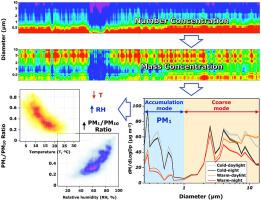Atmospheric Pollution Research ( IF 3.9 ) Pub Date : 2021-09-14 , DOI: 10.1016/j.apr.2021.101201 Luis Felipe Sánchez P. 1 , Carlos A. Manzano 1, 2 , Manuel A. Leiva-Guzmán 1 , Mauricio Canales A. 1 , Richard Toro Araya 1

|
A monitoring campaign of the atmospheric particulate matter (PM) size distribution (between 0.25 and 10 μm in diameter (Dp)) in an urban area with high levels of air pollution between June 2018 and May, 2019 is presented. The relative contribution of 24 size fractions to the total number and mass concentration of PM was analyzed using an aerosol spectrometer. Local meteorological parameters and their effect on the PM concentrations were also evaluated. The size-fractionated particle mass concentrations showed the accumulation (Dp < 1 μm) and coarse (1 μm < Dp < 10 μm) modes. The highest contribution of the accumulation mode was observed during autumn and winter (reaching 99.7 % and 35.2 % of the total number and mass concentrations, respectively). High relative humidity and low temperatures were strongly correlated with high concentrations for the smaller PM fractions, which can be connected to the increase of residential emissions of PM derived from wood burning sources in winter months. The larger PM fractions showed higher concentrations during the spring and summer months, potentially because of dust resuspension due to the high vehicular traffic in the vicinity. High PM concentrations of the larger fractions were favored by the lack of precipitation events and stronger winds during this time of the year. The results showed the importance of the PM1 fraction to improve the source apportionment studies in urban areas and provide information about the potential health effects associated to high PM concentration events.
中文翻译:

智利圣地亚哥城市大气粒径分布
介绍了 2018 年 6 月至 2019 年 5 月期间空气污染严重的城市地区的大气颗粒物 (PM) 粒径分布(直径 (Dp) 介于 0.25 至 10 微米之间)的监测活动。使用气溶胶光谱仪分析了 24 种尺寸分数对 PM 总数和质量浓度的相对贡献。还评估了当地气象参数及其对 PM 浓度的影响。粒度分级的颗粒质量浓度显示出累积 (Dp < 1 μm) 和粗 (1 μm < Dp < 10 μm) 模式。在秋季和冬季观察到积累模式的最高贡献(分别达到总数和质量浓度的 99.7% 和 35.2%)。较高的相对湿度和低温与较小的 PM 部分的高浓度密切相关,这可能与冬季月份来自木材燃烧源的 PM 居民排放量增加有关。在春季和夏季月份,较大的 PM 部分显示出较高的浓度,这可能是由于附近车辆交通繁忙导致灰尘再悬浮。在一年中的这个时候缺乏降水事件和强风,有利于较大部分的高 PM 浓度。结果表明 PM 的重要性 可能是因为附近车辆交通繁忙导致灰尘重新悬浮。在一年中的这个时候缺乏降水事件和强风,有利于较大部分的高 PM 浓度。结果表明 PM 的重要性 可能是因为附近车辆交通繁忙导致灰尘重新悬浮。在一年中的这个时候缺乏降水事件和强风,有利于较大部分的高 PM 浓度。结果表明 PM 的重要性1分数以改进城市地区的源分配研究,并提供有关与高 PM 浓度事件相关的潜在健康影响的信息。











































 京公网安备 11010802027423号
京公网安备 11010802027423号